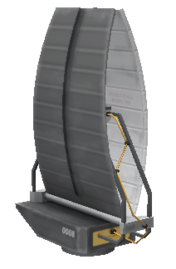M700 Survey Scanner
| M700 Survey Scanner | ||
| Scanner by Experimental Engineering Group | ||
| Radial size | Small, Radial mounted | |
| Cost | (total) | 1 500.00 |
| Mass | (total) | 0.200 t |
| Drag | 0.2 | |
| Max. Temp. | 2000 K | |
| Impact Tolerance | 7 m/s | |
| Research | | |
| Unlock cost | 4 500 | |
| Since version | 1.0 | |
| Part configuration | SurveyScanner.cfg | |
| Mode | Orbital | |
| Resource | All | |
| Scanning time | 5 s | |
| Science bonus | 10 | |
| Min. Altitude | 25 000 m [1] | |
| Max. Altitude | 1 500 000 m [2] | |
| Packed volume | None | |
|
| ||
The M700 Survey Scanner is an orbital low resolution resource scanner. It is used to map broad areas of resource concentration on a celestial body. It is the first step in finding locations which are rich in resources, for subsequent extraction. It provides a low detail overview of the entire celestial body, which can then be used to target specific areas for further detailed scanning with high resolution scanners (which can only scan a small area, not an entire celestial body).
Product description
| “ | This orbital survey scanner uses a combination of advanced sensor technology and witchcraft to provide information on a planet or moons natural resources. These images can be viewed either in flight, or in relative safety and comfort back at the KSC. Be sure to bring an antenna capable of transmitting the information back, and sufficient power. — Experimental Engineering Group |
” |
Usage
The scanner works well on a small 1.25m satellite, but has a large electrical demand when activated, so a Z-1k battery, or equivalent, is recommended. The electrical demand is brief, so it is not necessary to have a huge generating capacity. It is not particularly heavy, so a FL-T200 fuel tank and LV-909 engine are quite adequate for the final stage, providing the necessary power to establish and adjust the orbit, either from LKO to Mun and Minmus, or entry from solar orbit to another system. An antenna is required to upload the data back to KSC, and any antenna will suffice.
Launching should probably make use of a payload fairing or cargo bay, as the scanner is large and not a good aerodynamic shape, so is likely to cause atmospheric control issues when placed on top of a rocket. The scanner requires a stable polar orbit at an appropriate altitude (see below). Once established in orbit, it must first be opened (Deploy Scanner), then the scan can be performed (Perform orbital survey). The scan is a once per body operation, and only takes a few seconds. The data acquired by the scanner is automatically transmitted, and it is the transmission which uses the large quantity of electricity. The scan result can be viewed in map mode (default M key) while controlling the scanner satellite, or from the KSC Tracking Station. To view the results in map mode, right-click on the scanner while it is deployed and select Toggle Overlay. To view the results from the Tracking Station, select the orbital body and then click on the Resources icon on the right hand side of the window. The deployed scanner can be retracted by clicking on the Retract Scanner option.
There are options to change the data presentation. You can modify the display cutoff value (the higher the value, the richer the deposit) and the results' color and style. You cannot change these parameters from map mode. Retracting the scanner will hide the results until the scanner is re-deployed and the overlay is toggled again.
After using this scanner, it is possible to start resource extraction based on its results alone, but the best results will be achieved by using the scan results as the basis for performing detailed, targeted scans with the high resolution scanners:
Scanning altitude
| Celestial body | Radius | Altitude | |
|---|---|---|---|
| Min. | Max. | ||
| Kerbol | 261.6 Mm | N/A | N/A |
| Moho | 250 km | 25 km | 1.25 Mm |
| Eve | 700 km | 70 km | 1.5 Mm |
| Gilly | 13 km | 25 km | 65 km |
| Kerbin | 600 km | 60 km | 1.5 Mm |
| Mun | 200 km | 25 km | 1000 km |
| Minmus | 60 km | 25 km | 300 km |
| Duna | 320 km | 32 km | 1.5 Mm |
| Ike | 130 km | 25 km | 650 km |
| Dres | 138 km | 25 km | 690 km |
| Jool | 6 Mm | 600 km | 1.5 Mm |
| Laythe | 500 km | 50 km | 1.5 Mm |
| Vall | 300 km | 30 km | 1.5 Mm |
| Tylo | 600 km | 60 km | 1.5 Mm |
| Bop | 65 km | 25 km | 325 km |
| Pol | 44 km | 25 km | 220 km |
| Eeloo | 210 km | 25 km | 1.05 Mm |
The scanner has a minimum and maximum scanning altitude based on the radius of the body it is scanning:
- The minimum altitude is one-tenth of the body radius or 25 km, whichever is higher.
- The maximum altitude is five times the body radius or 1.5Mm, whichever is lower.
Changes
- Initial release

